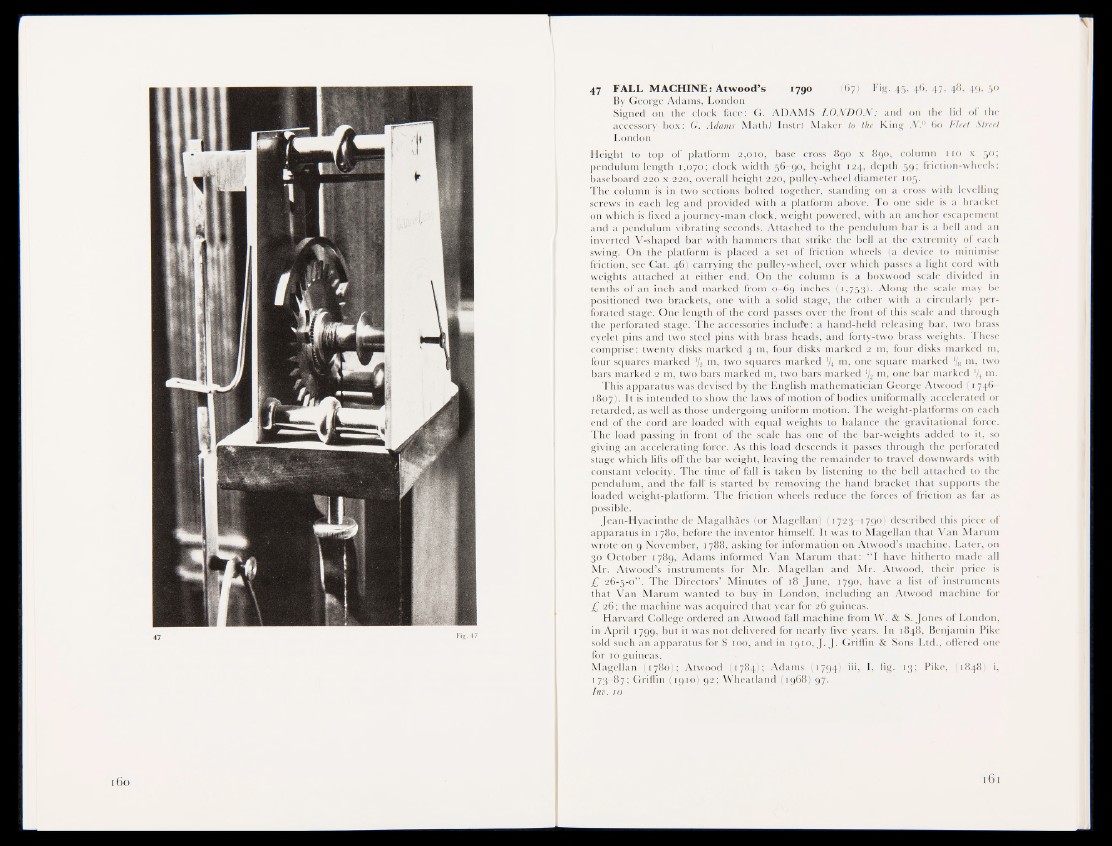
47 FALL MACHINE: Atwood’s I 7 9 ° (67) Fig- 45, 46, 47, 48, 49, 50
By George Adams, London
Signed on the clock face: G. ADAMS LONDON; and on the lid of the
accessory box: G. Adams Math! Instr! Maker to the King JV.a 60 Fleet Street
London
Height to top of platform 2,010, base cross 890 x 890, column 110 x 50;
pendulum length 1,070; clock width 56—90, height 124, depth 59; friction-wheels:
baseboard 220 x 220, overall height 220, pulley-wheel diameter 105.
The column is in two sections bolted together, standing on a cross with levelling
screws in each leg and provided with a platform above. To one side is a bracket
on which is fixed a journey-man clock, weight powered, with an anchor escapement
and a pendulum vibrating seconds. Attached to the pendulum bar is a bell and an
inverted V-shaped bar with hammers that strike the bell at the extremity of each
swing. On the platform is placed a set of friction wheels {a device to minimise
friction, see Cat. 46); carrying the pulley-wheel, over which passes a light cord with
weights attached at either end. On the column is a boxwood scale divided in
tenths of an inch and marked from 0—69 inches (1,753). Along the scale may be
positioned two brackets, one with a solid stage, the other with a circularly perforated
stage. One length of the cord passes over the front of this scale and through
the perforated stage. The accessories includes: a hand-held releasing bar, two brass
eyelet pins and two steel pins with brass heads, and forty-two brass weights. These
comprise: twenty disks marked 4 m, four disks marked 2 m, four disks marked m,
four squares marked 1/i m, two squares marked fern, one square marked l/s m, two
bars marked 2 m, two bars marked m, two bars marked ‘/2 m> one bar marked l/4 m.
This apparatus was devised by the English mathematician George Atwood (1746-
1807) . It is intended to show the laws of motion of bodies uniformally accelerated or
retarded, as well as those undergoing uniform motion. The weight-platforms on each
end of the cord are loaded with equal weights to balance the gravitational force.
The load passing in front of the scale has one of the bar-weights added to it, so
giving an accelerating force. As this load descends it passes through the perforated
stage which lifts off the bar weight, leaving the remainder to travel downwards with
constant velocity. The time of fall is taken by listening to the bell attached to the
pendulum, and the fall' is started by removing the hand bracket that supports the
loaded weight-platform. The friction wheels reduce the forces of friction as far as
possible.
Jean-Hyacinthe de Magalhaes, for Magellan) (1723-1790) described this piece of
apparatus in 1 780, before the inventor himself. It was to Magellan that Van Marum
wrote on 9 November, 1788, asking for information on Atwood’s machine. Later, on
30 October 1789, Adams inforrried Van Marum that: “ I have hitherto made all
Mr. Atwood’s instruments for Mr. Magellan and Mr. Atwood, their price is
£ 26-5-0” . The Directors’ Minutes of 18 June, 1790, have a list of instruments
that Van Marum wanted to buy in London, including an Atwood machine for
£ 26; the machine was acquired that year for 26 guineas.
Harvard College ordered an Atwood fall machine from W. & S. Jones of London,
in April 1799, but it was not delivered for nearly five years. In 1848, Benjamin Pike
sold such an apparatus for $ 100, and in 1910, J. J. Griffin & Sons Ltd., offered one
for 10 guineas.
Magellan (1780); Atwood (1784)4 Adams (1794) iii, I, fig. 13; Pike, (1848) i,
173-87; Griffin (1910) 92; Wheatland (1968) 97.
Inv. 10